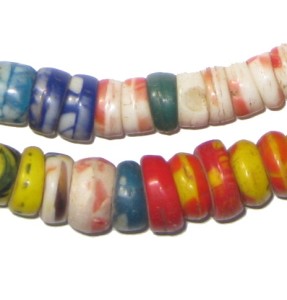

Multicolored Prosser Beads
Prosser Beads (also known as Kakamba Prosser Beads) refer to glass Trade Beads made by the Prosser “cold paste” technique, conceived by English brothers Richard and Thomas Prosser in 1840 for the purpose of manufacturing porcelain buttons. The process entails molding cold paste under significant pressure to achieve individual shapes, before it is fired.
Recognizing that the Prosser technique could potentially be adopted for beads, French button-maker and bead collector Jean-Felix Bapterosses bought the rights to the technique sometime in the 1850s. However, Bapterosses soon realized the paste used for the Prosser technique was too inflexible for making beads. After some experimentation, he discovered that the addition of cow’s milk made the paste far more malleable, and also achieved a sheen not dissimilar to porcelain. Inspired by the popularity of Venetian Trade Beads, he began to produce pressed beads on a massive scale at his factory in Briare, France, for use as currency by European merchants.
Prosser Beads were distinct from other European trade beads in that they were produced in a great variety of colors, and were also translucent. They were received particularly well in the town of Kakamba in the Republic of the Congo – hence the name Kakamba Prosser Beads. According to natives, Prosser Beads were deliberately strung upon weak string so that they would break easily, in turn creating an almost constant demand for more. Kakamba natives were also told it was sacrilegious to pick them up, which is why pockets of discarded beads continue to be found on farmland throughout the region.
References:
“The French Connection.” Bead Collector
Prosser Beads. Beadazzled.